Use a PDF for a Slide Show
A PDF of slides, or any document if in the correct aspect ratio, can be used for presentation slides. I am using Adobe Acrobat, but most PDF viewing apps have the same capability.
Here is my sample 16×9 presentation of 4 slides exported as a PDF, now open in Acrobat.
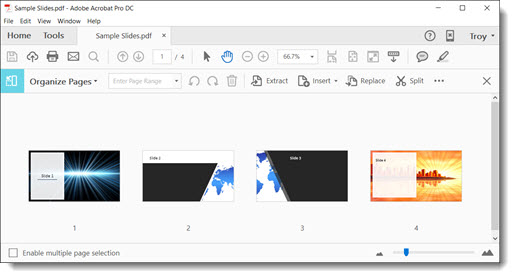
I have selected the first page vs. the Organize/Grid view.
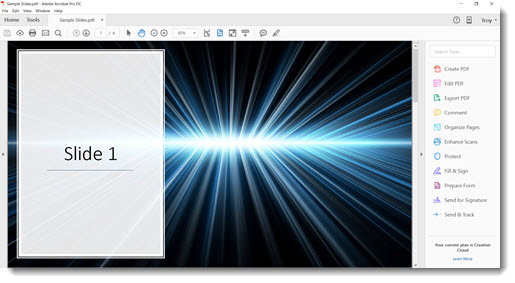
Go to VIEW > FULL SCREEN MODE, or use the keyboard shortcut CTRL+L
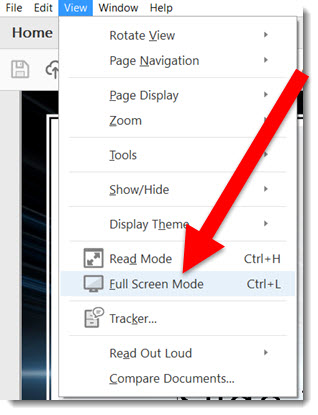
The Acrobat tool bars disappear and the slide displays full screen. Using the arrow keys or Page Up/Down keys, you can go through the pages just like a presentation.
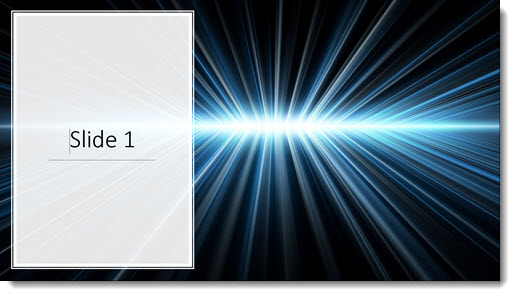
Notes:
- No animation
- No slide transitions
- No video or audio (There are ways to add these, but not covered in this tutorial, and not part of PowerPoint’s PDF export)
- Cannot be added to a master slide deck of all presenter slides (This is a separate file that just look like slides)
- No presenter view (Duplicate display is recommended vs. extended desktop)
-Troy @ TLC
What about LED wall “projection”?
LED walls are becoming the new standard for displaying video and presentations. The viewing quality of a build-to-any-size LED wall is already great, and they continue to get better! These screens have a resolution that is the same concept as projectors having resolution, their resolution is visible, it is the physical space between each light pixel. The closer/tighter the light spacing, the higher the resolution.

But projectors and LED walls measure light and brightness differently. Projection = lux, reflected light. LED = NIT, direct light. What does this mean? It means that LED walls, like flat panel displays, are brighter, which is great for slides!
Plus, LED walls are like Lego blocks, they can be built into any shape and aspect ratio. This leads to some fun and creative PowerPoint templates! For example, these are LED walls that used a single, custom, PowerPoint template for their content.

An LED wall can be a great option for presentations.
-Troy @ TLC
US Letter Size PowerPoint Template (Free!)
As promised in Episode 6 of The Presentation Podcast , Print Only Presentations (which actually releases tomorrow), here is the PowerPoint template setup in US Letter 8.5 x 11″ Portrait size. All layouts have been customized to fit the letter size page plus a few additional layouts using multi-column text boxes!
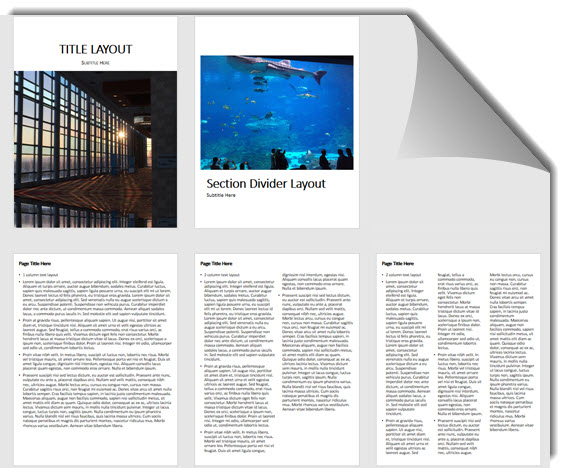
To download the template, click here (330K).
-Troy @ TLC
Text Aliasing and Anti-Aliasing
Picking a font style is important. Should it be a “safe” font, a professional font, a bold font, etc.? Any font style needs to display well and anti-aliasing is a big part of that. So, what is anti-aliasing?

The simple description of anti-aliasing is that it makes fonts display with smooth curves and angles, not jagged, low res looking edges. So if “anti-aliased ” is smooth, the opposite, hard edged fonts would make sense to be called “aliased.” However, the better term is “bit-mapped.”
Here’s a visual showing Aliased and Anti-Aliased Text:
Aliased (Jagged, Hard Edges):

Anti-Aliased (Smooth Edges):
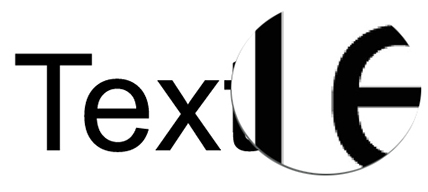
The good news is PowerPoint applies anti-aliasing to text (which has not always been the case). But it is applied when in slide show. Objects and text may appear to have jagged edges (aliased) when editing. Anti-aliasing is also applied when printing, but through a different ‘engine’ than when presented. So, when running as a slideshow, everything is smooth, when printing, everything is (almost always smooth), when editing, it may not look as smooth.
In addition, Microsoft Windows OS has its own term and feature for anti-aliasing called ClearType. ClearType is basically Microsoft’s technology for doing anti-aliasing and making fonts have nice smooth curves and angles. ClearType is currently used by web browsers (all web browsers) and the operating system dialogs. But not Microsoft Office at this time.
On PowerPoint, when using the PowerPoint web app it is viewed through a browser for editing and slideshow. So, all text is anti-aliased in both views because the Microsoft ClearType works with all major web browsers.
So, should you be worried about anti-aliasing or smooth fonts with PowerPoint? Yes, it is a concern, but with Windows 10 and PowerPoint 2007-2010-2013-2016 all fonts display anti-aliased in slideshow – and I can attest to being happy with text that is projected 20′ tall is HD is smooth and looks good (with the caveat that there is room for it to be better!).
-Troy @ TLC
The Presentation Podcast is Now On SoundCloud!
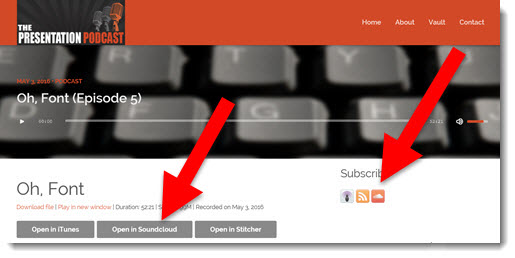
We have added Soundcloud to the ways to get The Presentation Podcast! Just click the SoundCloud icon available on each episode page!
How to Install Custom Fonts
Custom fonts can make a presentation unique, dynamic, align with corporate branding and many other fantastic things. But if a custom font is not installed on the device being used to show the presentation, the presentation may fail visually.

If your presentation is using a custom font, here is an overview on how to get that font installed on all the main device types – if it is possible to install.
Windows Desktop OS
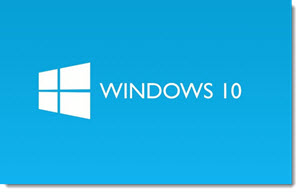
Installing a custom font is a simple process on Windows.
Option 1: Select Install
Confirm the font files are copied to the computer (not on a portable drive or network folder). Right-Click the font file and select > Install. Windows will do everything and the font is now available to all programs on that computer.
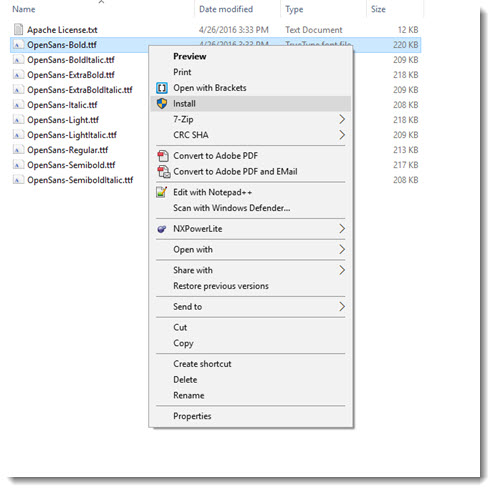
Option 2: Drop and Drag into Fonts Folder
Manually copy font files into the Windows Fonts folder. When a font file is copied into the Windows Font Folder it is automatically installed.
Windows 10: To see what fonts are installed, go to the Windows icon> Settings > type “Fonts” in the search bar on the top right. Your fonts folder should open, displaying currently installed fonts. Drag-and-drop, or copy/paste, font files to be installed.
Win XP, 7 and Win 8.1: To see what fonts are installed, go to Windows Start > Control Panel > Fonts, this will take you to a list of all fonts installed on your PC. Drag-and-drop, or copy/paste, font files to be installed.
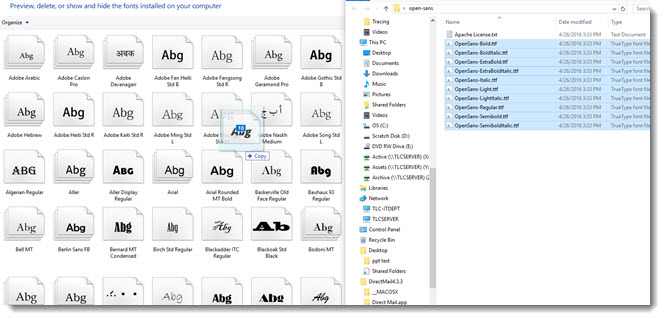
A few notes about PowerPoint using custom fonts on Windows:
- PowerPoint (all versions) can only recognize TrueType (TTF) and OpenType (OTF) formats.
- PowerPoint needs to be opened, or restarted, AFTER the custom font is installed. If a font is installed while PowerPoint is open, it will not show up in the font list until PowerPoint is restarted.
Mac OS
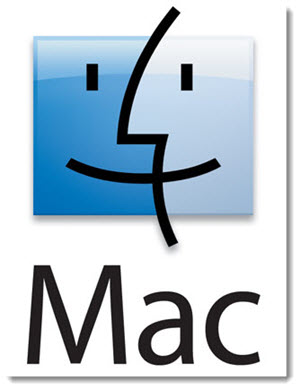
Option 1
- Double-click the font file to open a dialog fonts displaying the font. Click “Install Font” button.
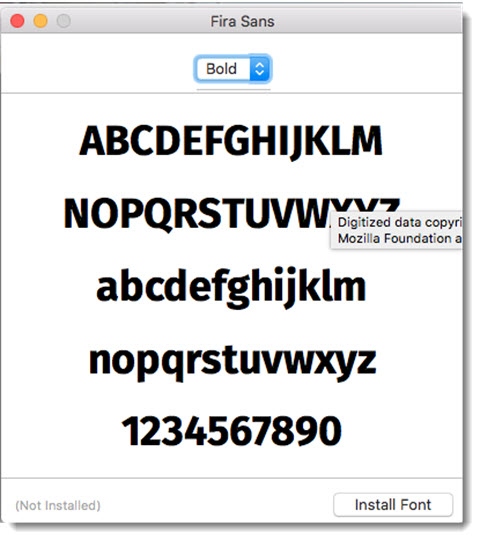
Option 2
- Launch Font Book, a Mac OS application. This displays all fonts on the computer. Choose Add Fonts from the file menu and select the font you want to install.
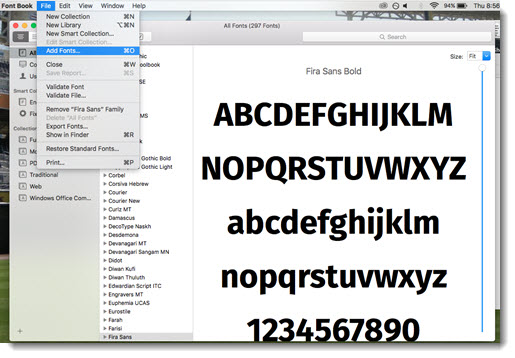
A few notes about PowerPoint and Keynote using custom fonts on the Mac OS:
- PowerPoint and Keynote can use TrueType (TTF), OpenType (OTF), and PostScript (PS) formats.
- The Mac OS fonts cannot be used on Windows computers.
- PowerPoint needs to be opened, or restarted, AFTER the custom font is installed. If a font is installed while PowerPoint is open, it will not show up in the font list until it is restarted.
- Keynote dynamically recognizes newly installed custom fonts and are immediately available without restarting the app
iOS on iPad and iPhone

- Custom fonts can be download and installed, but not all apps can use/see the custom fonts.
- iOS uses TrueType (.TTF) and OpenType (.OTF) fonts.
- PowerPoint for IOS installs with selection of preset “safe” fonts that are available on all platforms.
- Microsoft has recently implemented a new dynamic font library that will download and install additional fonts if they are used in a presentation. The presentation opens and if the font is not currently installed on the iOS device, a substitute font is automatically used. Then in the background, if the device has online access, the additional fonts are downloaded, installed and the presentation is dynamically updated to use the fonts. So a slide with a font not currently installed (but a Microsoft font) may initially display with a font substitution, and while you are looking at it, change to the correct font that has been downloaded and added to PowerPoint’s font library.
- The dynamically installed fonts on iOS are only “Office compatible” fonts, or fonts from Microsoft. So true custom fonts, non-Microsoft fonts, are not available.
- Keynote application uses the preset fonts installed with IOS. Third party apps can be used to install other fonts onto the IOS device, which are then available to Keynote.
Android and Chromebooks
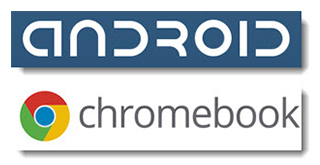
- Android uses TrueType (.TTF) and OpenType (.OTF) font formats.
- The Android OS is similar to IOS, it has preset fonts installed. There are several addon apps that allow additional fonts to be installed.
- One confusing thing when talking about fonts for Android is they have a font named “Android” and another named “Droid”, but other fonts are available. what happens when other fonts are used in a presentation – I will send details when I get them so you can add to post)
- PowerPoint for Android installs with selection of preset “safe” fonts that are available on all platforms.
- Microsoft has recently implemented a new dynamic font library that will download and install additional fonts if they are used in a presentation. The presentation opens and if the font is not currently installed on the Android device, a substitute font is automatically used. Then in the background, if the device has online access, the additional fonts are downloaded, installed and the presentation is dynamically updated to use the fonts. So a slide with a font not currently installed (but a Microsoft font) may initially display with a font substitution, and while you are looking at it, change to using the correct font that has been downloaded and added to PowerPoints font library.
Windows Mobile Phone
- Windows 10 Mobile installs with a preset list of fonts.
- Additional fonts cannot be installed on Windows 10 Mobile beyond those provided with the OS and the ones apps add.
- Microsoft has recently implemented a new dynamic font library that will download and install additional fonts if they are used in a presentation. The presentation opens and if the font is not currently installed on the Win10 Mobile device, a substitute font is automatically used. Then in the background, if the device has online access, the additional fonts are downloaded, installed and the presentation is dynamically updated to use the fonts. So a slide with a font not currently installed (but a Microsoft font) may initially display with a font substitution, and while you are looking at it, change to using the correct font that has been downloaded and added to PowerPoint’s font library.
- The dynamically installed fonts on iOS are only “Office compatible” fonts, or fonts from Microsoft. So true custom fonts, non-Microsoft fonts, are not available.
Prezi
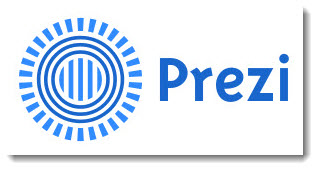
Prezi is not a device, but because it can be used on all devices listed, here is basic overview of font use by Prezi.
- Prezi uses preset fonts from its own font library. All of the Prezi fonts are mapped to common Microsoft fonts (for example, Prezi’s Arimo font, maps to Arial)
- If the desktop version of Prezi is used, custom fonts can be used, but only on desktop Prezi and it can be tricky to have Prezi recognize the custom, non-Prezi, True-Type fonts.
- Prezi uses .Keg (Prezi’s own font format) and TrueType (.TTF) Fonts.
- A nice option is the ability to install the full Prezi font library on your computer if desired. Here is a tutorial on the process: https://prezibase.com/how-to-use-custom-fonts-in-prezi-tutorial/
PowerPoint Web App
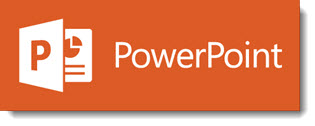
- The online version of PowerPoint can be used on all devices in a web browser. PowerPoint online is basically the same story as Windows 10 Mobile – it has a list of preset fonts and no additional fonts can be added to the list. But Microsoft has expanded list with additional fonts as this variation of PowerPoint has matured.
-Troy @ TLC
Can I Use Google Fonts?
PowerPoint and Google Fonts:
- Professional fonts that display great in presentation apps (PowerPoint, Keynote, Adobe apps, etc.).
- The ENTIRE library is FREE!
- Primarily for web use and designed to dynamically load when a website or web-connected app uses them (so they do not need to be installed on a device to be used. Unfortunately both PowerPoint and Keynote are not able to leverage the web-based dynamic use of Google Fonts).
- Can be downloaded as actual font files, installed on any computer, and both PowerPoint and Keynote can use them.
- A few considerations about using locally installed Google Fonts in PowerPoint and Keynote:
- get previous post details.
Details about Google Fonts
- Google describes their font collection as “hundreds of free, open-source fonts optimized for the web.”
- They have 708 font “families” (a Family is one typeface with several styles).
- Find them here.
- The online Google Fonts viewer has some great features, that can be used on any device. All fonts are displayed with a sample sentence that you can change to be any test. There are also options to see fonts used in a sample paragraph, a single word or very large in poster size text (good example for presentation callouts).
- The ENTIRE library can be downloaded!
- Use the down arrow icon in upper right of webpage to download Google Fonts to your computer.
- Optionally, fonts.com has the SkyFonts app which works with Google Fonts and works similar to the Adobe Typekit. It will sync selected fonts to any computer that has the SkyFonts app installed. Go to it here.
- Download the library at GitHub here.
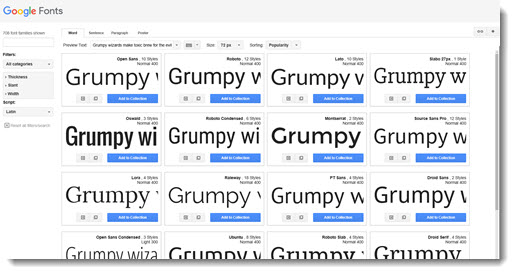
So, should Google Fonts be a part of your workflow?
Adding Google Fonts to your presentations is a good option, assuming you are prepared for managing Custom Fonts in a presentation and assuring everyone has knowledge of how to install custom fonts on a computer, has web access to get the font to install, and is prepared for things not displaying as designed if not installed. The other consideration is, do you need another font option? With our internal library of thousands of custom fonts, and the addition of Adobe Typekit providing its thousands of fonts to our design options, too many options can be more to manage and may provide more design options that are not really needed. But, Google Fonts is a great resource every presentation designer has available if needed.
-Troy @ TLC


